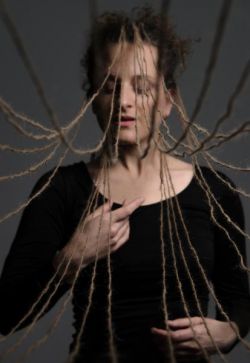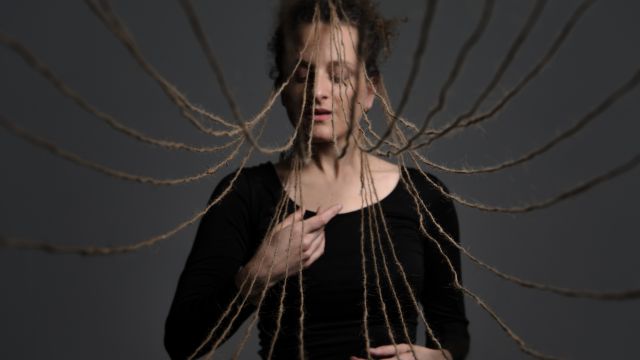Perspectiva Artificialis
Fiona Rutkay has a face that would not be out of place in a Renaissance painting. This gives an added poignancy to her show that opposes, I think, emotion, feeling, and physical experience of the world, against Euclid’s eight principles (definitions of a point, a line, a plane, and so on), that sound so abstract, and the ‘laws’ of perspective. These laws, ‘discovered’ in the Renaissance, changed forever drawing and painting from flat two-dimensional depictions to those having an illusion of depth – that is, as the human eye does see the external world – but not necessarily as the whole human being feels it.
In her program note, Ms Rutgay says that she came to question the validity of the perspective model, so that she had to ‘rethink how [she] could make art now that [she] could no longer use the model [she] was so familiar with.’
Rachel Joy’s set design (in collaboration, I’m sure, with Ms Rutkay and co-creator Jack Moon) cleverly suggests a frame and a vanishing point by simple but striking means: a white square frame is suspended downstage centre, and a smaller white square frame is suspended upstage. Behind the smaller frame, on the playing space wall, we imagine – we can’t do otherwise - the vanishing point.
When Ms Rutgay quotes Brunelleschi and draws the perspective lines with elegant hand gestures, we can see the pre-picture ’reality’ divided into sections and the lines stretching away. These white squares frame Ms Rutkay as she explains things – such as the laws of perspective. But they also frame contradictory or opposing emotions in her interpretive dance. She is, or was, a trained ballet dancer. Basically – and I hope I am not too reductive – she opposes dance to rules.
 Here, crucially, she is continually escaping the frames or, so to speak, refusing to let the frames contain her. Her movements do not have straight lines. She does not conform to the perspective grid. She defies it – although it is inert and indifferent. At some points, she tries (but interestingly fails) to climb through the frames.
Here, crucially, she is continually escaping the frames or, so to speak, refusing to let the frames contain her. Her movements do not have straight lines. She does not conform to the perspective grid. She defies it – although it is inert and indifferent. At some points, she tries (but interestingly fails) to climb through the frames.
I am not sure I understand her ‘parallels between ballet and perspective technique’, nor how the ‘dancer’s body itself is like a perspective model, though which the dancer sees, feels and expresses herself’. Does she mean that in ballet – classical ballet – a set of rules and restriction are placed on the dancer – as rules and restrictions are placed on the ‘realist’ painter - and that these constrain the artist, leaving her with means quite inadequate to express thought, feeling and lived experience of the world?
I wonder too whether she has really ‘questioned the validity of the perspective model’ rather than offering a heartfelt critique of it. Its validity per se remains - as a tool or a discipline that the artist can use or escape, depending on what is to be expressed.
What her presentation does express or seeks to express is the tension between a model imposed on reality as a sine qua non, and reality itself. It is particularly apposite in coming from a female artist, implying the opposition between straight lines (male) and circular or curved forms (female) as the camp or village became a city, long before the discovery of perspective, described by Mumford in The City in History.
Perhaps unfortunately, however, this show is more intellectual argument, more lecture, more statement, than dramatization of her thesis, interesting as it is. Her delivery of text needs more force to expose the ironies. Her argument relies so much on her dancing in contrast to the rules and so it needs to exhibit more struggle and more pain in defying the perspective model that she feels as an imposition on her.
Michael Brindley
Subscribe to our E-Newsletter, buy our latest print edition or find a Performing Arts book at Book Nook.

